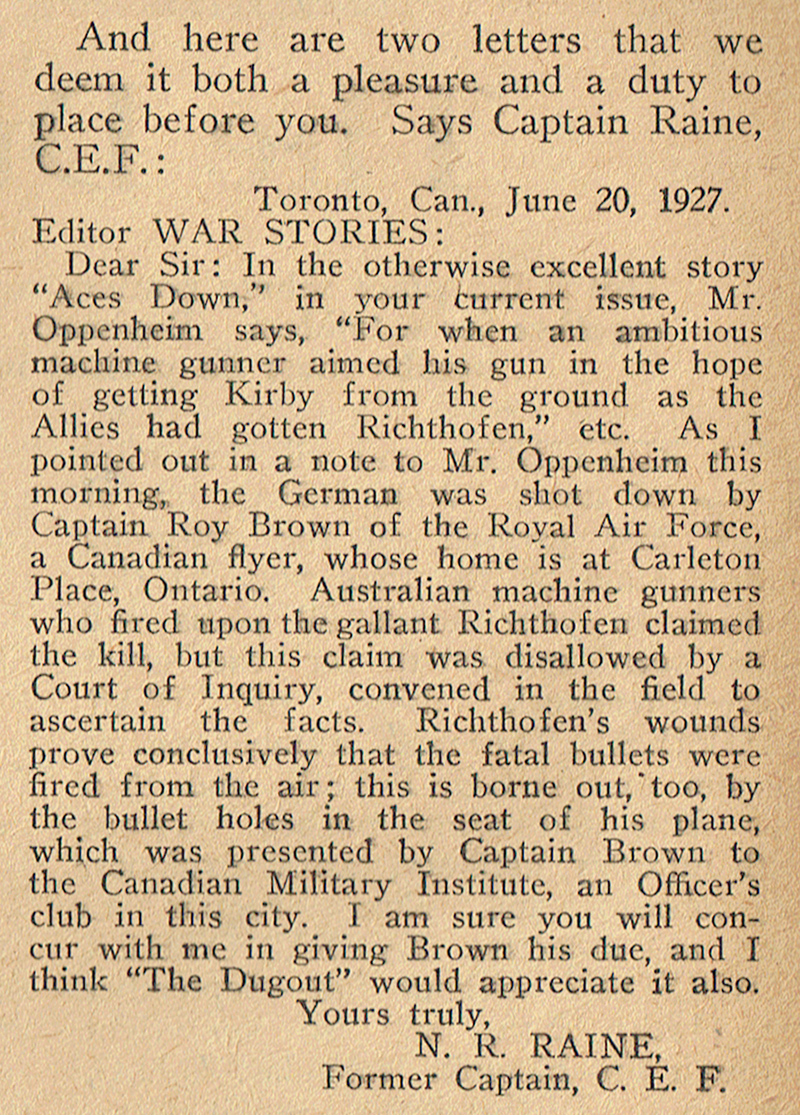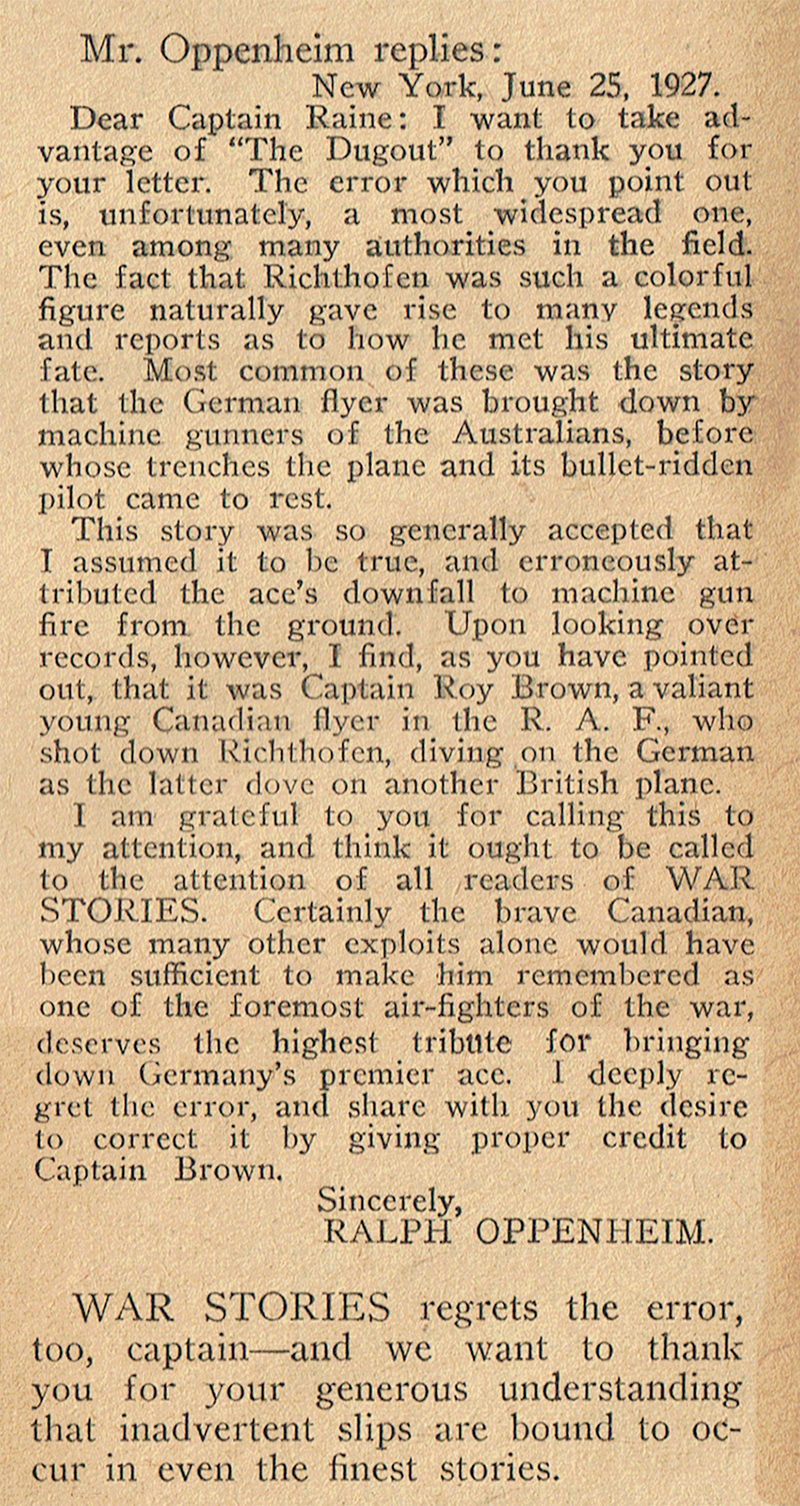BACK in 2015 during our first Mosquito Month, we ran a series of articles from The Pocono Record that covered Oppenheim’s Magic Puppet World. In 2019 we ran an additional article from the nearby Allentown Morning Call. But what celebration of the Three Mosquitoes and their creator and chronicler Ralph Oppenheim could go by without a mention of Oppenheim’s Magic Puppet World? Especially since we just came upon an artifact from the time!
Yes, just recently we stumbled upon one of the hand-made pennants that they used to sell at the gift shop at Oppenheim’s!

It’s a small orange felt pennant measuring 3¾” x 8¼” with heavy dark blue yarn ties. Emblazoned upon it are the words “Magic Puppet World” and a joyous printed figure with a wooden ball head and red body with arms up and legs spread.

While the hair is painted with a fine brush; Mrs. Oppenheim paints the eyes, nose and mouth with a cellophane cone filled with lacquer.
So in celebration of finding the pennant, we’re presenting another article from The Pocono Record we passed over due to it’s poor picture—but it does have lots of good information.
Oppenheim puppets tireless performers for visitors
The Pocono Record, Stroudsburg, Pa • 20 July 1968
SCIOTA — In Sciota, right off old Route 209 there Is a continuous show going on and—a lot of show for the money!
Its performers are the puppeteerless puppets of Oppenheim’s magic puppet world who, If animated, would be a highly unionized group of theatricals with large overtime paychecks and gleeful over their immunity from artistic exploitation.
Alas, however, they are inanimate and by fate, doomed to dance their little logs off until their repertoire is exhausted and the last Pocono vacationer who has heard of them in the course of a day, leaves the theatre.
Their creator is Ralph Oppenheim who, having dreamed them up in the first place and having possessed unwavering convictions for their artistic immortality, remains their impressario.
Their choreography is attributed to Shirley Oppenheim, and their current manager (no pun intended) is the local light company—another way of saying that a highly artistically endowed man and wife team, in an old converted barn in Sciota, are the owners of automation-controlled puppetry, nationally recognized as a completely new medium of entertainment.
Ingenious Creativity
The experience of those who will be visiting this unusual Pocono attraction will doubtless provoke admiration for the ingenious creativity, singularly Oppenheim, which lies behind the magic puppet show. Audiences will probably be divided.
There will be those who will approach the show on a purely emotional level and get a royal bang out of the rescue of Juliet by two rival Romeos; or the vagaries of the mind in “The Dollmaker’s Dreamâ€; or the little clown being shot from a cannon in “The Cannonball Clowns”; or the ballerina dancing down a stairway before her solo in “The Doll Ballet.”
Other Segment
The other segment of the audience will be those of strong engineering and mechanical leanings who will try to figure out “what makes the wheels go around”, and probe the intricacies of the cams, cogs, and cajoles of the moving parts, all Einsteinian manifestation of the Oppenheim mind.
Many prefer the emotional approach to entertainment, not impervious, however, to appreciating the daily vicisitudes of the Oppenheims who have to concern themselves with the delicate “taut†of the finest silk thread, the humidity level and its influence on equipment, etc., to assure that the clown in “Cannonball Clowns” really does get booted out of the cannon before the thread holding him up doesn’t throw a fit in the form of a French knot.
There is an element of promotion in Oppenheim’s advertising slogan “15 years in the making”, but that’s not the whole slury. It excludes the “ups and downs” the couple have known which is ail part of the slow evolution of their art from consumated, as its stands today. Their story is a success story, but predicted on trial and error.
A New Yorker, Oppenheim first invented a textile machine for weaving with “raffia,” a coarse grass, which hitherto was considered uneavable.
He made purses, baskets, hand crafts, etc., which found a market outlet in Philadelphia. Automating puppetry, however, was always a childhood fantasy, and he began devoting eight years after weaving with raffia, to developing his first puppet piece, a figure ten inches high, mounted on a pedestal, and producing a large shadow. A department store got interested.
The mechanism’s cams, drums’ and levers, pull strings however, through constant interplay wore out, and he lost it.
His “Miss Muffet” puppet was born in 195B and he toted it around, caressingly to attract interested ones in the exhibit fields, and in trade shows. This attracted Westinghouse, and also Bell Telephone at the Chicago Museum of Science and Industry. He also had productions at the New York World’s Fair.
Country Living
The couple finally expatriated New York City in quest for country living and through the process of elimination, finally chose the Paconos.
As one might have guessed, Shirley Oppenheim, with a former career in art and ballet, pools her talent with her gifted husband, in their old barn, the old Art Ruppert barn in whose cornerstone is chiseled the dale 1858, they happily live their life of artistic activity, and in the dead of winter, winterize themselves in the barn’s lower level and make arts and crafts for their gift shop.
Every item in the shop is their own creation. They have, two devoted dogs, and that is their family.
Their Magic Puppet World opens in May and closes October 20. It Is a world where science and artistry combine to bring new magic to puppetry, enjoyed by all through a modest admission charge.
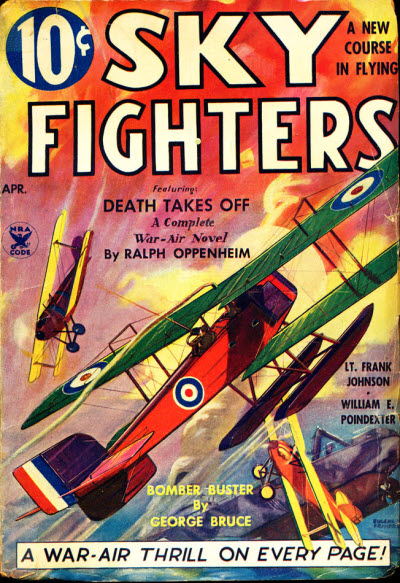 Mosquito Month we have a non-Mosquitoes story from the pen of Ralph Oppenheim. In the mid thirties, Oppenheim wrote a half dozen stories for Sky Fighters featuring Lt. “Streak” Davis. Davis—ace and hellion of the 25th United States Pursuit Squadron—was a fighter, and the speed with which he hurled his plane to the attack, straight and true as an arrow, had won him his soubriquet. Once more it’s a battle against time as Streak must retrieve vital information about Pershing’s big push against Hindenburg that had been left behind in a locked safe when the Boche over ran the villa that had been an Allied held town. From the April 1935 issue of Sky Fighters it’s “Death Takes Off!”
Mosquito Month we have a non-Mosquitoes story from the pen of Ralph Oppenheim. In the mid thirties, Oppenheim wrote a half dozen stories for Sky Fighters featuring Lt. “Streak” Davis. Davis—ace and hellion of the 25th United States Pursuit Squadron—was a fighter, and the speed with which he hurled his plane to the attack, straight and true as an arrow, had won him his soubriquet. Once more it’s a battle against time as Streak must retrieve vital information about Pershing’s big push against Hindenburg that had been left behind in a locked safe when the Boche over ran the villa that had been an Allied held town. From the April 1935 issue of Sky Fighters it’s “Death Takes Off!”




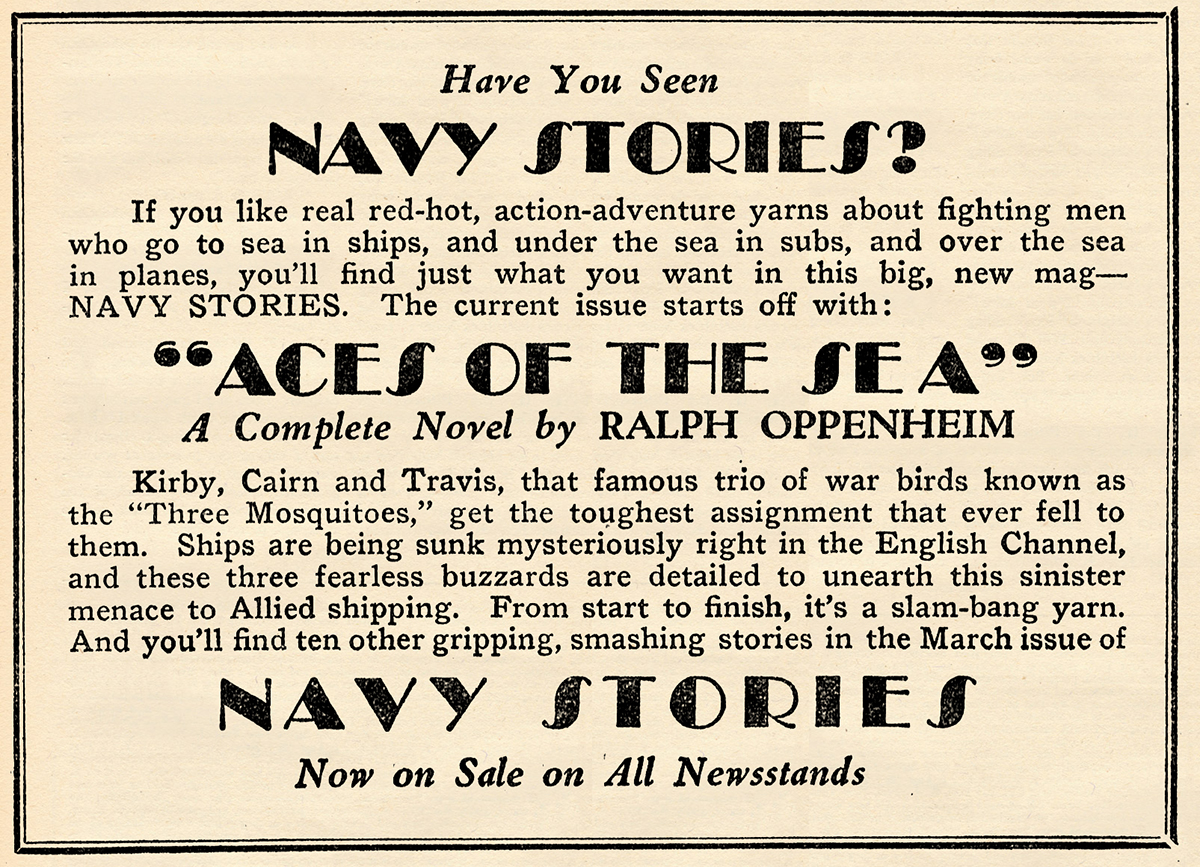
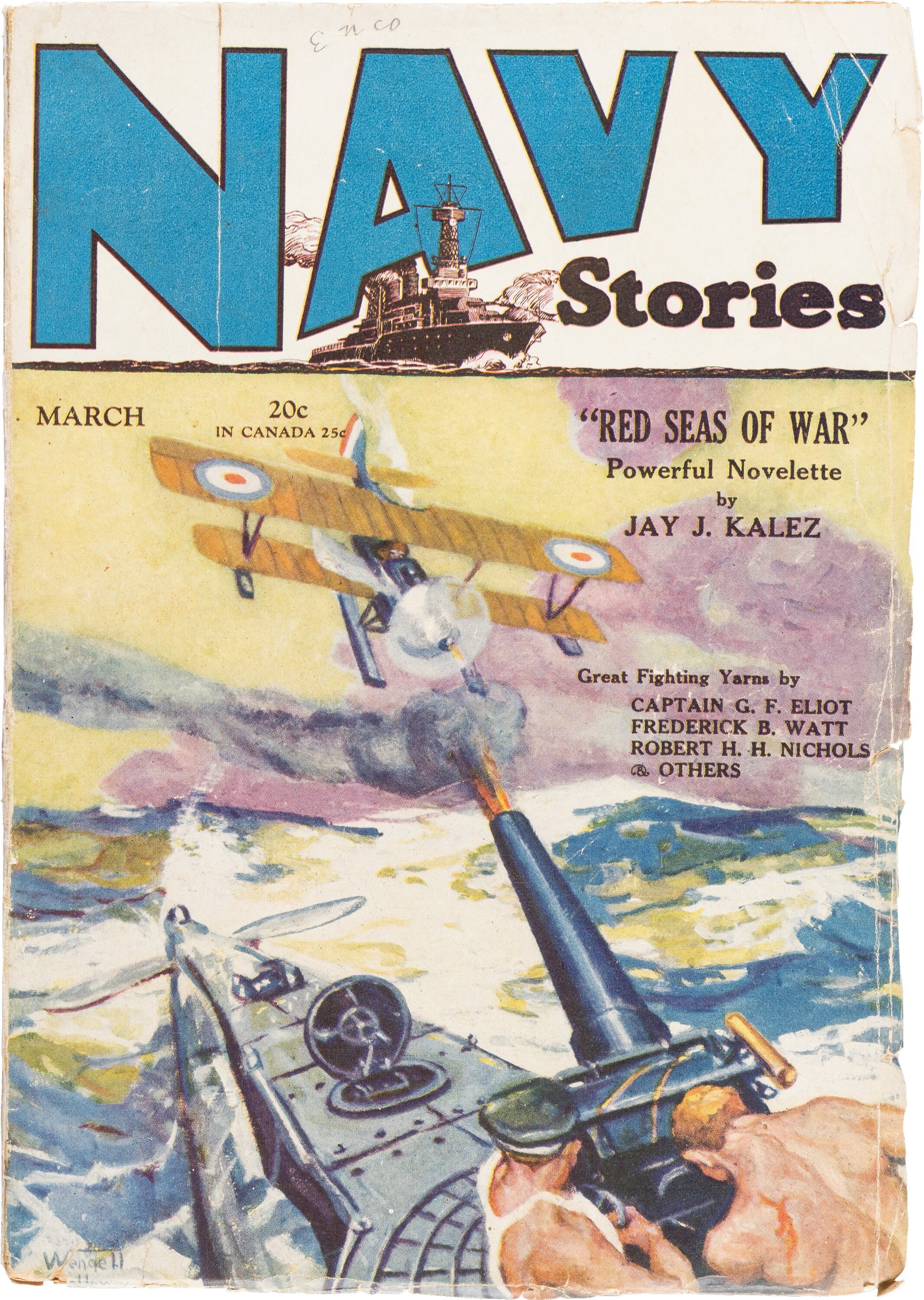 the third of three Three Mosquitoes stories we’re presenting this month. This week it’s a bit of a departure for the inseparable trio when they are loaned out to the Navy. Somehow, under our very noses in the heavily mined and patrolled waters of the English Channel, six ships have disappeared without a trace and no survivors. The Navy has designed a trap that they hope will catch or reveal what has happened to their missing ships and The Three Mosquitoes are to fly over the area to observe whatever happens. And that’s just the tip of this iceberg—events lead Kirby to be an unwilling passenger/prisoner aboard a U-boat bent on a hellish suicide mission to destroy Englands new super dreadnaught about to set sail! From the March 1929 issue of Navy Stories, it’s “Aces of the Sea!”
the third of three Three Mosquitoes stories we’re presenting this month. This week it’s a bit of a departure for the inseparable trio when they are loaned out to the Navy. Somehow, under our very noses in the heavily mined and patrolled waters of the English Channel, six ships have disappeared without a trace and no survivors. The Navy has designed a trap that they hope will catch or reveal what has happened to their missing ships and The Three Mosquitoes are to fly over the area to observe whatever happens. And that’s just the tip of this iceberg—events lead Kirby to be an unwilling passenger/prisoner aboard a U-boat bent on a hellish suicide mission to destroy Englands new super dreadnaught about to set sail! From the March 1929 issue of Navy Stories, it’s “Aces of the Sea!”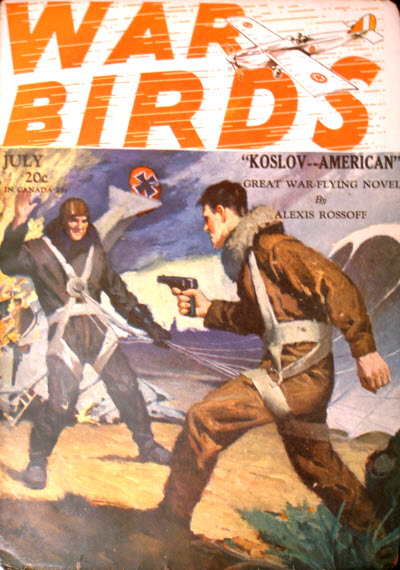 the second of three Three Mosquitoes stories we’re presenting this month. Nach Felt 21. Field 21. Important, time-sensitive information needs for an Allied offensive against the Boche has been hidden in the crotch of a forked tree down a dirt path in the woods on Field. 21. Intelligence operatives have been unable to retrieve this informations a last ditch effort, they figure a lone flyer may be able to land on the field, retrieve the information, and get out before the Germans in the area could stop them. Kirby is this flyer. Landing in the midst of German troops and retrieving the info is the easy part, keeping his two pals—Travis and Carn from tagging along is the hard part. From the July 1928 issue of War Birds, it’s “Stacked Cards!”
the second of three Three Mosquitoes stories we’re presenting this month. Nach Felt 21. Field 21. Important, time-sensitive information needs for an Allied offensive against the Boche has been hidden in the crotch of a forked tree down a dirt path in the woods on Field. 21. Intelligence operatives have been unable to retrieve this informations a last ditch effort, they figure a lone flyer may be able to land on the field, retrieve the information, and get out before the Germans in the area could stop them. Kirby is this flyer. Landing in the midst of German troops and retrieving the info is the easy part, keeping his two pals—Travis and Carn from tagging along is the hard part. From the July 1928 issue of War Birds, it’s “Stacked Cards!”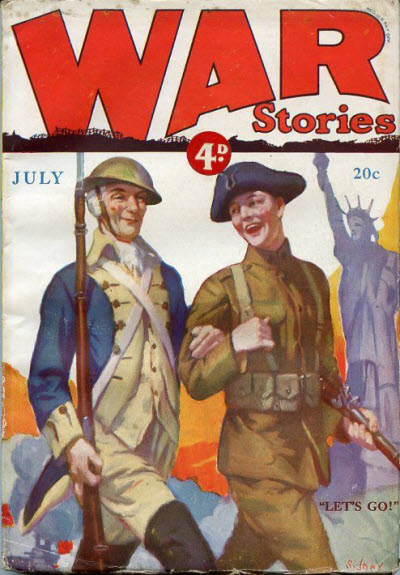 get things off the ground with Oppenheim’s very first Three Mosquitoes tale from the pages of War Stories from July 1927! This premier tale finds the inseparable trio separated following a stunting attack on the front line trenches that resulted in Carn and Travis going down behind enemy lines and captured and an humiliated Kirby being sent down to ferrying new ships to their assigned fields. Mindless, boring work for the beaten Ace—his instructions are to avoid all altercations and steer far clear of any action what so ever. Especially since the plane he’s flying and those of the other ferried ships have no guns! But that doesn’t stop Kirby when he sees the Block brothers sniffing around the very secluded forrest the Allies are amassing troops and supplies—he tries to find a way to stop them from getting that information back across the lines without the benefit of guns!
get things off the ground with Oppenheim’s very first Three Mosquitoes tale from the pages of War Stories from July 1927! This premier tale finds the inseparable trio separated following a stunting attack on the front line trenches that resulted in Carn and Travis going down behind enemy lines and captured and an humiliated Kirby being sent down to ferrying new ships to their assigned fields. Mindless, boring work for the beaten Ace—his instructions are to avoid all altercations and steer far clear of any action what so ever. Especially since the plane he’s flying and those of the other ferried ships have no guns! But that doesn’t stop Kirby when he sees the Block brothers sniffing around the very secluded forrest the Allies are amassing troops and supplies—he tries to find a way to stop them from getting that information back across the lines without the benefit of guns!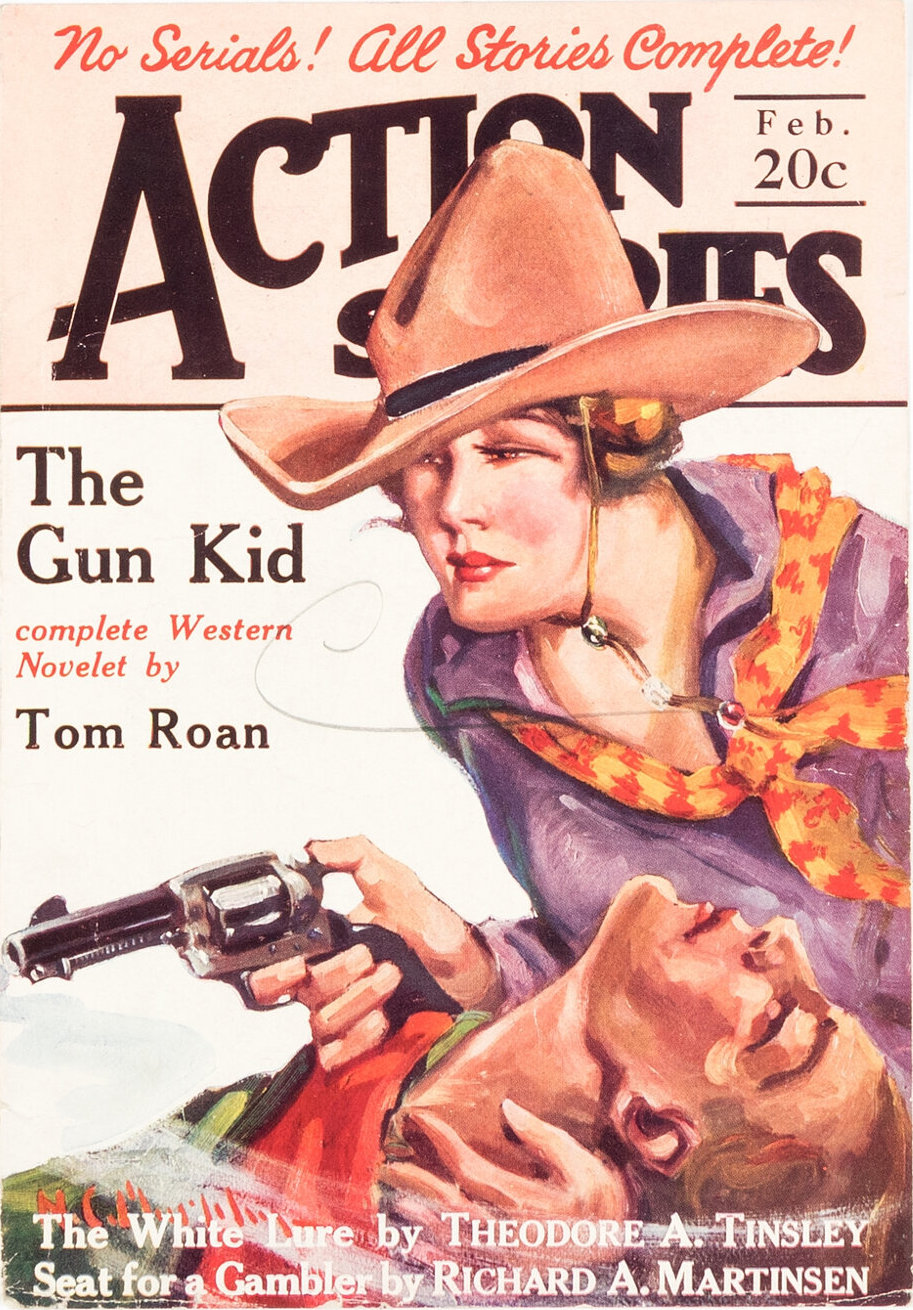 the pulps takes place at an Army Arsenal, whose innocent-looking buildings housed enough T.N.T. to blow up a fair-sized city. Although every safety precaution had been put in place, it seemed disaster was unavoidable when a letter arrived from an anarchist:
the pulps takes place at an Army Arsenal, whose innocent-looking buildings housed enough T.N.T. to blow up a fair-sized city. Although every safety precaution had been put in place, it seemed disaster was unavoidable when a letter arrived from an anarchist: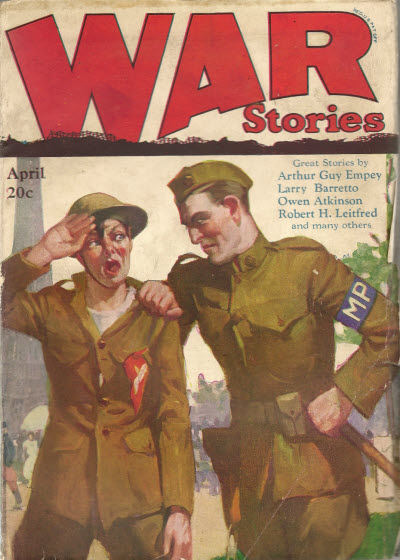 published pulp story was another aviation tale, this time for the pages of Dell’s War Stories for April 1927. In this second tale, John Slade is posted at an American base in France. Slade is to take a photographer over the lines in a two-seater observation crate without an escort in hopes of getting vital pictures of a ruined town the German’s are presently holding that the Allies want to take. Slade is an exceptional, daredevil pilot perfect for the job—his only fear is using a parachute! And this job may require that if he can’t get through the German’s A.A. guns and any planes they may send out to shoot them down. Will he be able to face his fears when the time comes?
published pulp story was another aviation tale, this time for the pages of Dell’s War Stories for April 1927. In this second tale, John Slade is posted at an American base in France. Slade is to take a photographer over the lines in a two-seater observation crate without an escort in hopes of getting vital pictures of a ruined town the German’s are presently holding that the Allies want to take. Slade is an exceptional, daredevil pilot perfect for the job—his only fear is using a parachute! And this job may require that if he can’t get through the German’s A.A. guns and any planes they may send out to shoot them down. Will he be able to face his fears when the time comes? 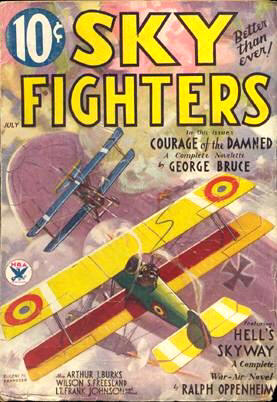 Mosquito Month we have a non-Mosquitoes story from the pen of Ralph Oppenheim. In the mid thirties, Oppenheim wrote a half dozen stories for Sky Fighters featuring Lt. “Streak” Davis. Davis was a fighter, and the speed with which he hurled his plane to the attack, straight and true as an arrow, had won him his soubriquet. And time is of the essence when Streak is sent on a bombing mission. He must destroy the Krupp Machine works at Luennes before they unleash German’s newest secret weapon at noon! From the July 1934 issue of Sky Fighters it’s “Hell’s Skyway!”
Mosquito Month we have a non-Mosquitoes story from the pen of Ralph Oppenheim. In the mid thirties, Oppenheim wrote a half dozen stories for Sky Fighters featuring Lt. “Streak” Davis. Davis was a fighter, and the speed with which he hurled his plane to the attack, straight and true as an arrow, had won him his soubriquet. And time is of the essence when Streak is sent on a bombing mission. He must destroy the Krupp Machine works at Luennes before they unleash German’s newest secret weapon at noon! From the July 1934 issue of Sky Fighters it’s “Hell’s Skyway!”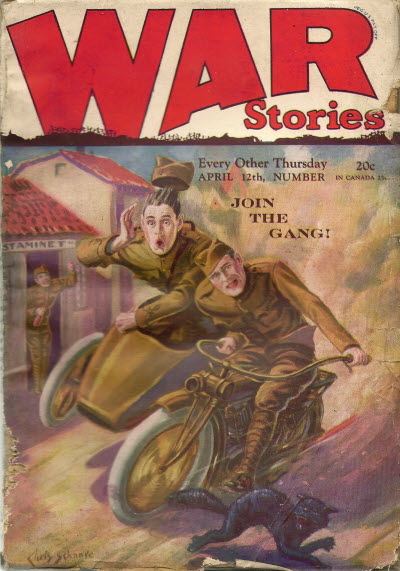 the third and final of three Ralph Oppenheim’s Three Mosquitoes stories we’re featuring this March for Mosquito Month! And this one’s a doozy! Kirby gets the unenviable job of test flying the new type Spad and putting it through its paces—including trying it in combat and shooting down a plane. But, under no circumstances should he take the new plane over the lines! Unfortunately that’s just what Kirby did! Read all about it in Ralph Oppenheim’s “An Ace of Spads” from the April 12th, 1928 issue of War Stories!
the third and final of three Ralph Oppenheim’s Three Mosquitoes stories we’re featuring this March for Mosquito Month! And this one’s a doozy! Kirby gets the unenviable job of test flying the new type Spad and putting it through its paces—including trying it in combat and shooting down a plane. But, under no circumstances should he take the new plane over the lines! Unfortunately that’s just what Kirby did! Read all about it in Ralph Oppenheim’s “An Ace of Spads” from the April 12th, 1928 issue of War Stories!

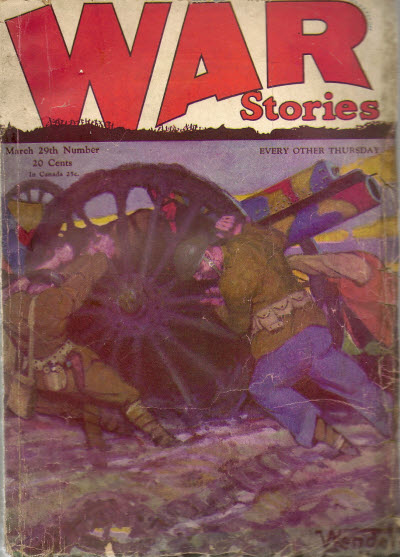 the second of three tales of Ralph Oppenheim’s Three Mosquitoes we’re featuring this March for Mosquito Month! This week, the intrepid trio is tasked with getting valuable information from behind German lines—but it’s a job for only one man which unfortunately turns into one man at time as each of the Mosquitoes is sent off to garner the information when the previous one fails to return. From the March 29th, 1928 issue of War Stories, it’s The Three Mosquitoes in “An Ace in the Hole!”
the second of three tales of Ralph Oppenheim’s Three Mosquitoes we’re featuring this March for Mosquito Month! This week, the intrepid trio is tasked with getting valuable information from behind German lines—but it’s a job for only one man which unfortunately turns into one man at time as each of the Mosquitoes is sent off to garner the information when the previous one fails to return. From the March 29th, 1928 issue of War Stories, it’s The Three Mosquitoes in “An Ace in the Hole!”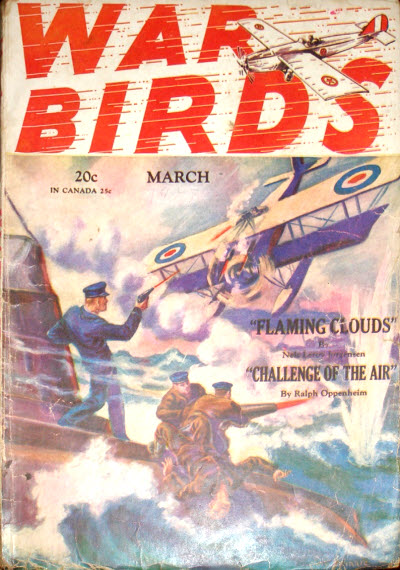 hit the stands in February 1928, it not only contained an exciting tale of Ralph Oppenheim’s inseparable trio The Three Mosquitoes, but it also had a rare factual piece by Mr. Oppenheim. Ralph and his younger brother Garrett had taken a trip to Europe the previous year and just happened to be there at the right time to be able to get to Paris and be there at Le Bourget Field on the 21st of May when Charles Lindbergh successfully ended his trans-Atlantic flight!
hit the stands in February 1928, it not only contained an exciting tale of Ralph Oppenheim’s inseparable trio The Three Mosquitoes, but it also had a rare factual piece by Mr. Oppenheim. Ralph and his younger brother Garrett had taken a trip to Europe the previous year and just happened to be there at the right time to be able to get to Paris and be there at Le Bourget Field on the 21st of May when Charles Lindbergh successfully ended his trans-Atlantic flight!




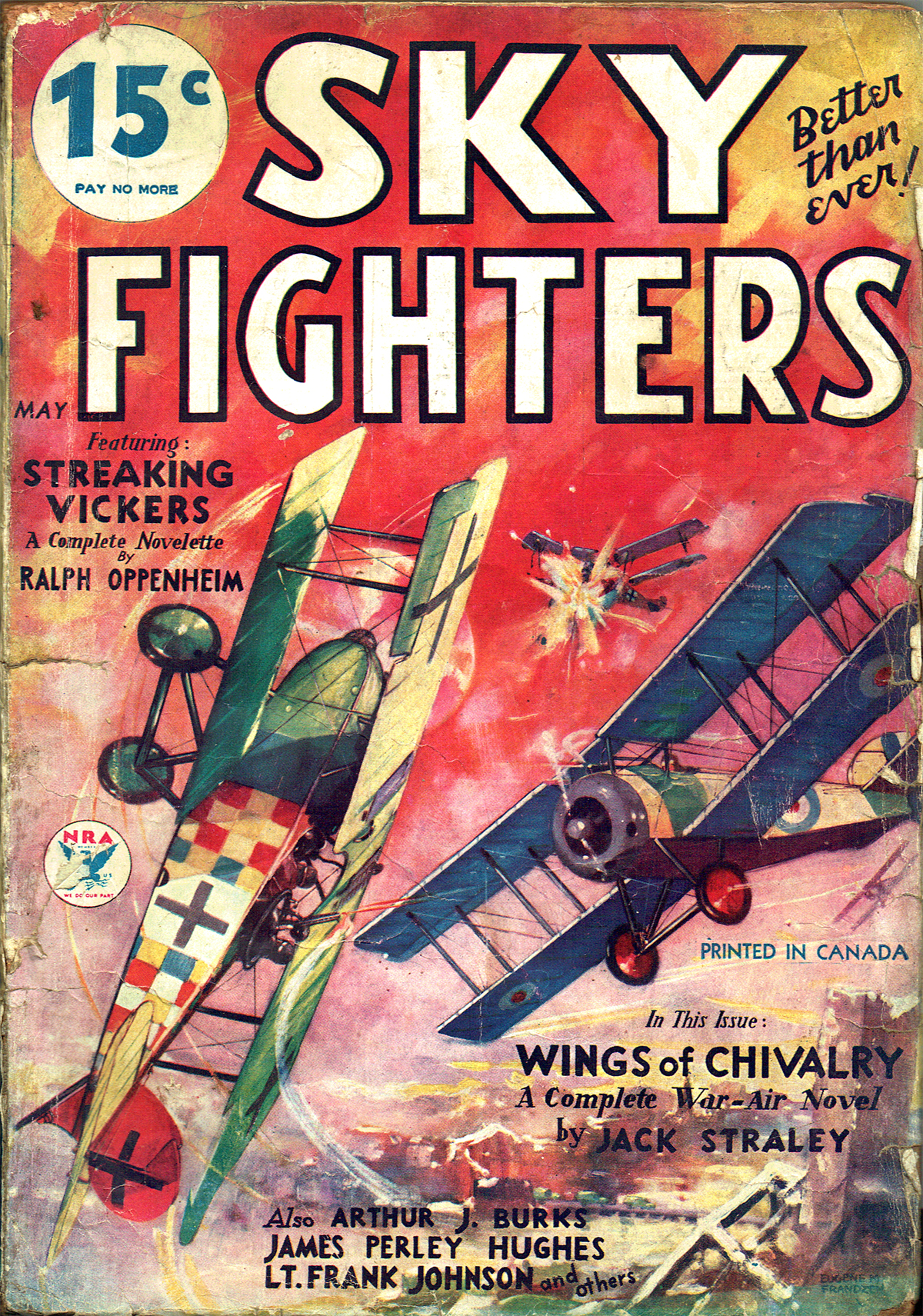 Mosquito Month we have a non-Mosquitoes story from the pen of Ralph Oppenheim. In the mid thirties, Oppenheim wrote a half dozen stories for Sky Fighters featuring Lt. “Streak” Davis. Davis was a fighter, and the speed with which he hurled his plane to the attack, straight and true as an arrow, had won him his soubriquet. Operating out of the 34th Pursuit Squadron, his C.O. sends him out to range the big guns to take out the enemy’s supply dump before the Hindenburg Push. From the May 1934 issue of Sky Fighters it’s “Streaking Vickers!”
Mosquito Month we have a non-Mosquitoes story from the pen of Ralph Oppenheim. In the mid thirties, Oppenheim wrote a half dozen stories for Sky Fighters featuring Lt. “Streak” Davis. Davis was a fighter, and the speed with which he hurled his plane to the attack, straight and true as an arrow, had won him his soubriquet. Operating out of the 34th Pursuit Squadron, his C.O. sends him out to range the big guns to take out the enemy’s supply dump before the Hindenburg Push. From the May 1934 issue of Sky Fighters it’s “Streaking Vickers!”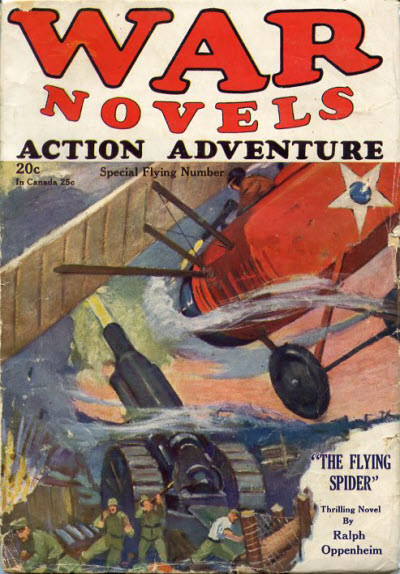 the third and final of three Ralph Oppenheim’s Three Mosquitoes stories we’re featuring this March for Mosquito Month! And this one’s a doozy! Who had not heard of that grim nickname—”The Spider”? It was the nickname of Germany’s most notorious spy—the plague and dread of the Allied powers. The whole Allied intelligence system was after this man, but they had never been able to catch him; he seemed to bear a charmed life. Kirby and his comrades had heard many rumors of his wild, hairbreadth escapades, but they had not known how truly deadly he was! And now the Three Mosquitoes found themselves caught in The Spider’s web! From the pages of the June 15th, 1929 issue of War Novels it’s Ralph Oppenheim’s “The Flying Spider!”
the third and final of three Ralph Oppenheim’s Three Mosquitoes stories we’re featuring this March for Mosquito Month! And this one’s a doozy! Who had not heard of that grim nickname—”The Spider”? It was the nickname of Germany’s most notorious spy—the plague and dread of the Allied powers. The whole Allied intelligence system was after this man, but they had never been able to catch him; he seemed to bear a charmed life. Kirby and his comrades had heard many rumors of his wild, hairbreadth escapades, but they had not known how truly deadly he was! And now the Three Mosquitoes found themselves caught in The Spider’s web! From the pages of the June 15th, 1929 issue of War Novels it’s Ralph Oppenheim’s “The Flying Spider!”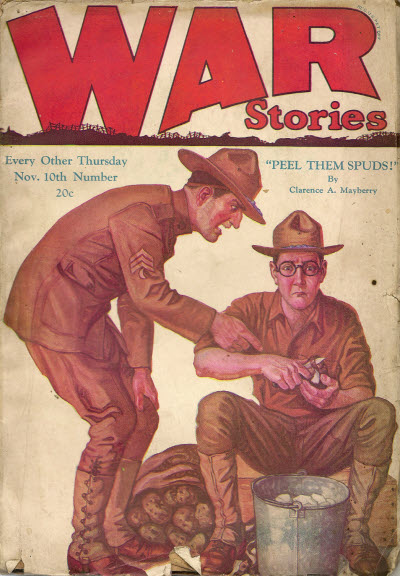 the second of three exciting tales of Ralph Oppenheim’s Three Mosquitoes we’re featuring this March for Mosquito Month! This week, The Three Mosquitoes past comes back to haunt them when the brother of the Black Devil, whom they dispatched in last week’s story, sends a challenge to Kirby in hopes of avenging his death!
the second of three exciting tales of Ralph Oppenheim’s Three Mosquitoes we’re featuring this March for Mosquito Month! This week, The Three Mosquitoes past comes back to haunt them when the brother of the Black Devil, whom they dispatched in last week’s story, sends a challenge to Kirby in hopes of avenging his death!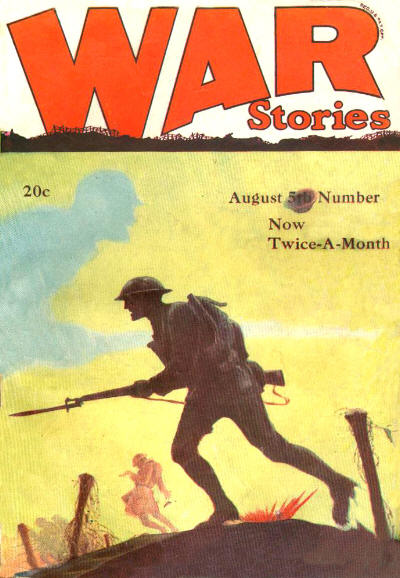 off the ground with what was believed to have been the first flight of the Three Mosquitoes. I say believed because according to both Robbin’s Index and the online
off the ground with what was believed to have been the first flight of the Three Mosquitoes. I say believed because according to both Robbin’s Index and the online 